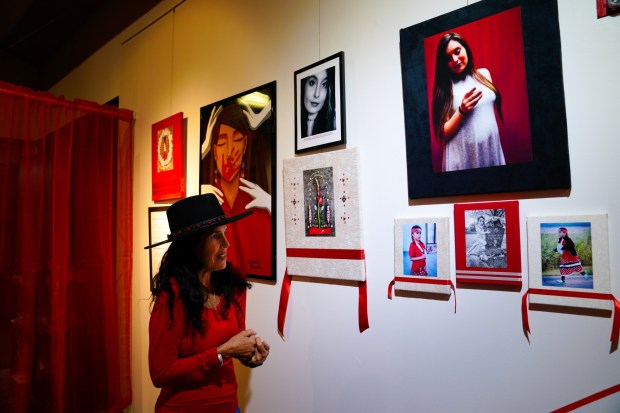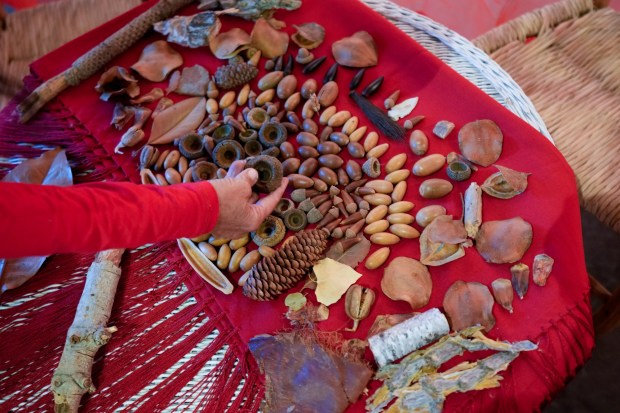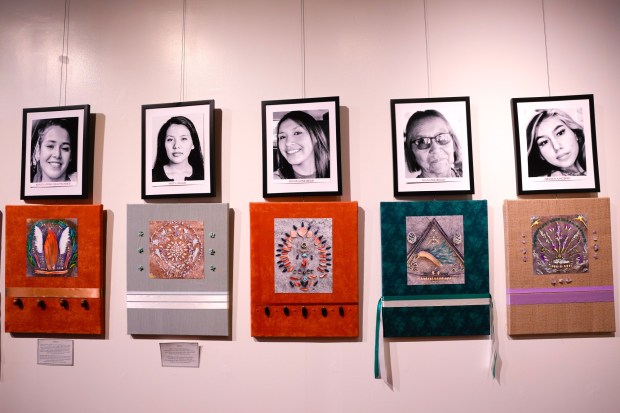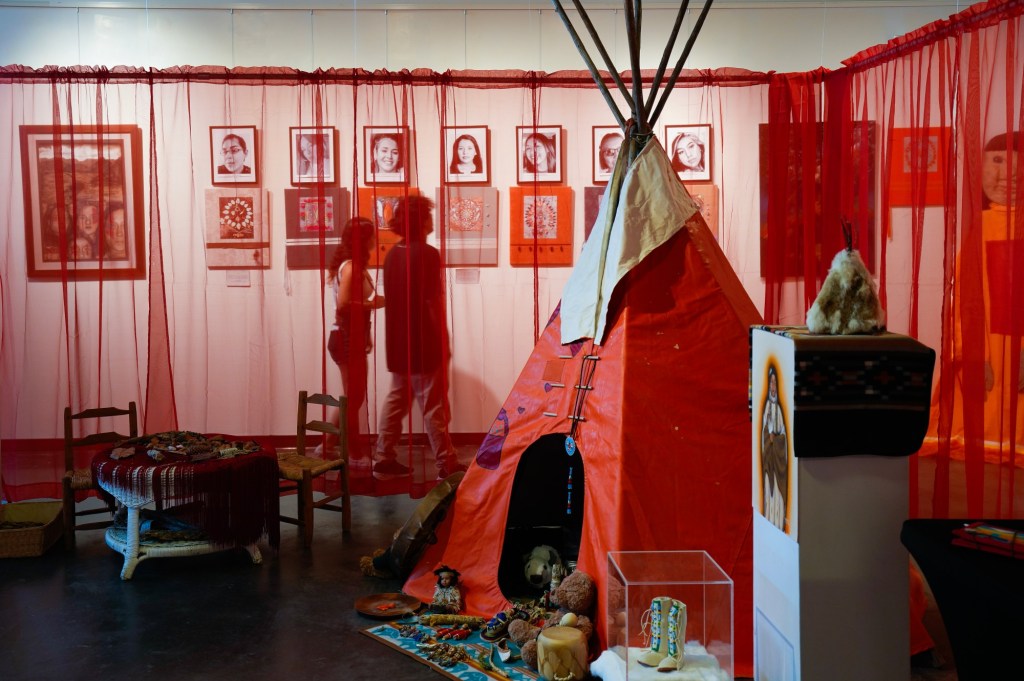In the Curator’s Words is an occasional series that takes a critical look at current exhibitions through the eyes of curators.
Through its exhibitions, museums use art as a way to educate, entertain and, almost always, elicit emotion. The Bonita Museum is most certainly hoping to educate and elicit emotion through its current show “Walking in Beauty: Life as Ceremony.”
The exhibit, which opened Nov. 8 and is on display through Nov. 30, “brings public awareness to missing and murdered Indigenous women,” according to the museum, run under the auspices of the Bonita Historical Society.
“Through sacred altars and installations by artivists from the Way of the Sacred Mountain organization, a healing space will allow for contemplation and prayer below the Mother Miguel mountain, which visitors can see from the museum.”
The museum’s Indigenous Cultures Educator, Heather Gallana, took some time to talk about the exhibition, with input from one of the curators, Teyana Viscarra.
 Artist Teyana Viscarra of Chula Vista helped curate the “Walking in Beauty: Life as Ceremony” exhibit at the Bonita Museum, on display through Nov. 30. (Nelvin C. Cepeda / The San Diego Union-Tribune)
Artist Teyana Viscarra of Chula Vista helped curate the “Walking in Beauty: Life as Ceremony” exhibit at the Bonita Museum, on display through Nov. 30. (Nelvin C. Cepeda / The San Diego Union-Tribune)
Q: Tell us about this exhibit and why it is so important for the public to see.
A: Art can send a message in a deeper way than words can. I think it’s important for the general public to be able to learn and grow with the Native community through an exhibition like “Walking in Beauty: Life as Ceremony.” Teyana and her team have worked hard to spread awareness to missing and murdered Indigenous women (MMIW) issues through art and cultural practices.
Q: What do you hope this exhibition will accomplish?
A: Teyana (Piro-Tiwa Pueblo, Apache, European) and Norm Sands (Yaqui, Apache, European) have dedicated their lives to pressing awareness for the MMIW movement. My hope for this exhibition is that our guests take a deeper look into these issues and connect to the message through the art displayed. People often seek out art to feel something. We see these issues in the news, but having this exhibition at the Bonita Museum will bring it closer to home than one may think. I hope with this exhibition our guests feel why this exhibition is so important.
Q: What was the genesis of this exhibit?
A: “Walking in Beauty: Life as Ceremony” is a powerful and sacred exhibition curated by members of Way of the Sacred Mountain, an Indigenous-led grassroots partnership — born from grief, spiritual calling and a commitment to confront the national crisis of missing and murdered Indigenous women.
Native women, as well as Indigenous men, boys and Two-Spirit people, face disproportionately high rates of violence and disappearance. This exhibit aims not just to raise awareness, but to create a ceremonial space for truth-telling and collective healing — a living memorial.
The genesis of the exhibit was inspired in 2017 when Viscarra, an artist and mountain prayer runner, attended a vigil for Savanna LaFontaine-Greywind, a young pregnant Indigenous woman who was murdered and had her baby stolen.
This horrific event ignited a spiritual commitment in Teyana, leading her to a three-year journey of sunrise prayer runs and the creation of earthen altars — offerings shaped by the land. Each sacred altar is paired with a missing or murdered woman whose story is honored, not just mourned.
 The “Walking in Beauty: Life as Ceremony” exhibit is on display at the Bonita Museum through Nov. 30. (Nelvin C. Cepeda / The San Diego Union-Tribune)
The “Walking in Beauty: Life as Ceremony” exhibit is on display at the Bonita Museum through Nov. 30. (Nelvin C. Cepeda / The San Diego Union-Tribune)
Q: Since this will incorporate a healing space for contemplation and prayer, is there a proper way of experiencing this exhibition? If so, what is that?
A: The movement deepened in 2021 with the disappearance of Maya Millete, an Indigenous Filipina mother from Chula Vista. With her family’s blessing, Teyana created “7 Peaks for 7 Sisters,” an annual prayer run across seven sacred peaks in San Diego County. Each peak honors one missing woman.
“7 Peaks for 7 Sisters” is a powerful fusion of physical sacrifice, prayer and remembrance. Teyana’s path crossed with Sands, an Indigenous photographer and activist known for the MMIW Red Tipi and shawls and bandanas. Together, they united their work under “One Prayer,” blending spiritual activism with advocacy for MMIW, environmental justice and Indigenous rights. They envisioned “Walking in Beauty” as both memorial and medicine.
The exhibit is more than art — it is ceremony. Visitors are invited to enter with humility and reverence. Installations like the Red Tipi Healing Prayer Space invite quiet contemplation, prayers and offerings.
Ultimately, “Walking in Beauty” is an act of remembrance, reclamation of Indigenous womanhood and resistance against colonial erasure. It offers space for grief to breathe and healing to begin, centering the voices of families and survivors who are too often silenced. The hope is to honor the enduring strength, beauty and sacredness of their people. This exhibit is a bold affirmation: “We are still here — and still beautiful.”
 Artist Teyana Viscarra of Chula Vista has created about 50 “Prayer Runs,” representing the missing and murdered Indigenous women, that are part the “Walking in Beauty: Life as Ceremony” exhibit at the Bonita Museum. (Nelvin C. Cepeda / The San Diego Union-Tribune)
Artist Teyana Viscarra of Chula Vista has created about 50 “Prayer Runs,” representing the missing and murdered Indigenous women, that are part the “Walking in Beauty: Life as Ceremony” exhibit at the Bonita Museum. (Nelvin C. Cepeda / The San Diego Union-Tribune)
Bonita Museum presents “Walking in Beauty: Life as Ceremony”
When: 10 a.m. to 4 p.m. Wednesdays through Saturdays. Through Nov. 30.
Where: Bonita Museum, 4355 Bonita Road, Bonita
Admission: Pay as you wish.
Phone: 619-267-5141
Online: bonitahistoricalsociety.org
